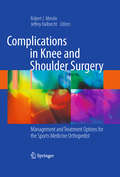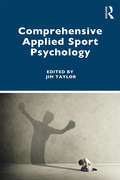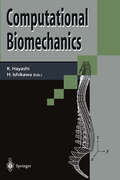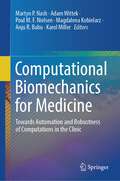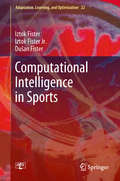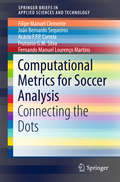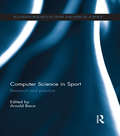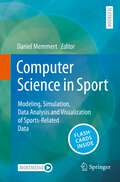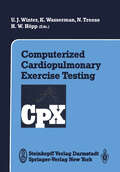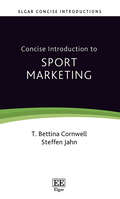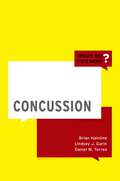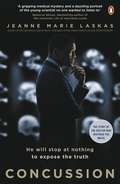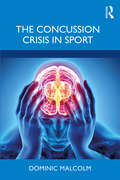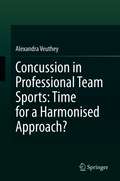- Table View
- List View
Complications in Knee and Shoulder Surgery: Management and Treatment Options for the Sports Medicine Orthopedist
by Robert J. Meislin Jeffrey Halbrecht“To Err is Human…” Alexander Pope Any surgical intervention has potential risks and complications. This book is designed as a reference tool and a roadmap for the sports medicine orthopedist to minimize the complications in knee and shoulder surgery. Some complications are avoidable; some are not. By understanding the functional anatomy at risk, proper surgical setup, proper equipment, and proper patient selection, a preventative approach to complications can be instituted. The authors of these chapters represent leaders in orthopedic sports medicine and have provided novel methods for dealing with intraoperative complications and si- ations that can occur in the midst of a “routine” arthroscopic reconstruction. In d- cussing these issues, we hope to raise the surgeon’s awareness of potential complications and to provide wisdom and advice to properly avoid and treat these problems should they arise. How one deals with complications truly tests the mettle of the surgeon. Keeping one’s “cool” in the midst of an intraoperative complication will be facilitated by h- ing an algorithmic approach. We hope that this book will improve your outcome should these problems occur. Some complications are unavoidable. Arthro brosis or stiffness may take place in the best of hands. Infection may surface postoperatively in the most sterile OR. We provide you with the background to confront these challenges. A list of ten “Pearls” are offered at the beginning of most chapters as a quick reference card.
Complications in Orthopaedics: Adult Reconstruction - E-Book
by Stephen A. ThompsonOne of the hallmarks of a master surgeon is the ability to navigate a wide variety of inevitable difficult situations in surgery, whether errors in judgment, technical mistakes, or unavoidable outcomes. Under the leadership of series editor Dr. Stephen R. Thompson, the Complications in Orthopaedics series provides real-world guidance on recognizing and avoiding errors, as well as how to “course-correct" during surgery. In this volume, Drs. P. Maxwell Courtney, Yale A. Fillingham, and a team of expert surgeons describe the most common errors and complications of adult reconstruction surgery, focusing on the knee and hip and demonstrating practical solutions that are integral to improving patient outcomes. Covers key topics such as Pain Management Following Total Hip Arthroplasty and Total Knee Arthroplasty, Achieving Balance and Stability During a Total Knee Arthroplasty, Unicompartmental Knee Arthoplasty, Neurovascular Injury in Total Hip Arthroplasty, Post-operative Periprosthetic Fractures in Total Hip Arthroplasty, Hip Preservation: Complications of PAO?, and many more. Describes and offers solutions to the most common or most devastating errors and complications in the practice of adult reconstruction surgery, combining the breadth of knowledge of academic surgeons with the in-the-trenches skills of community surgeons. Uses an easy-to-follow, standardized chapter format that covers preoperative errors, intraoperative issues, and postoperative complications. Includes procedural video clips to reinforce discussions in the text. Features a full-color design with numerous photographs, radiographs, and illustrations. Includes introductory material on relevant anatomy and necessary background information.
Complications in Orthopaedics: Sports Medicine E-Book
by Stephen R. ThompsonOne of the hallmarks of a master surgeon is the ability to navigate a wide variety of inevitable difficult situations in surgery, whether errors in judgment, technical mistakes, or unavoidable outcomes. Complications in Orthopaedic Surgery is a new series designed to provide real-world guidance on recognizing and avoiding errors, as well as how to “course-correct" during surgery. In this inaugural volume dedicated to sports medicine surgery, series editor Dr. Stephen R. Thompson and Dr. Matthew Schmitz describe and demonstrate practical solutions that are integral to improving patient outcomes.Covers a wide variety of procedures, including meniscus repair and transplantation, revision ACL reconstruction, pediatric ACL surgery, cartilage surgery in adults and children, knee osteotomies, acromioclavicular surgery, hip arthroscopy, and much more. Describes and offers solutions to the most common or most devastating errors and complications in the practice of sports medicine surgery, combining the breadth of knowledge of academicsurgeons with the in-the-trenches skills of community surgeons. Uses an easy-to-follow, standardized chapter format that covers preoperative errors, intraoperative issues, and postoperative complications. Includes procedural video clips to reinforce discussions in the text. Features a full-color design with numerous photographs, radiographs, and illustrations.
Comprehensive Applied Sport Psychology
by Jim TaylorThe aim of Comprehensive Applied Sport Psychology (CASP) is to challenge our field to look beyond its current status and propel applied sport psychology and mental training forward and outward with a broad and multi-layered examination of everything psychological, emotionally, and socially that the athletic community contends with in pursuit of athletic success and that sport psychologists and mental trainers do in their professional capacities. Comprehensive Applied Sport Psychology is the first professional book aimed at offering a truly expansive and deep exploration of just about everything that applied sport psychologists, consultants and mental trainers do in their work. CASP plumbs the depths of the athletic mind including attitudes, psychological and emotional obstacles, mental "muscles" and mental "tools," quality of sport training, the health and well-being of athletes, and other areas that are essential to athletic success. This new volume examines not only the many ways that consultants impact athletes, but also explores their work with coaches, teams, parents, and interdisciplinary groups such as sports medicine team and sports management. The book is grounded in both the latest theory and research, thus making it a valuable part of graduate training in applied sport psychology, as well as a practical resource for consultants who work directly with athletes, coaches, teams, and parents. The goal of CASP, in collaboration with dozens of the leading minds in the field, is to create the definitive guide to what applied sport psychology and mental training are and do.
Comprehensive Applied Sport Psychology
by Jim TaylorThe aim of Comprehensive Applied Sport Psychology (CASP) is to challenge our field to look beyond its current status and propel applied sport psychology and mental training forward and outward with a broad and multi-layered examination of everything psychological, emotionally, and socially that the athletic community contends with in pursuit of athletic success and that sport psychologists and mental trainers do in their professional capacities. Comprehensive Applied Sport Psychology is the first professional book aimed at offering a truly expansive and deep exploration of just about everything that applied sport psychologists, consultants and mental trainers do in their work. CASP plumbs the depths of the athletic mind including attitudes, psychological and emotional obstacles, mental "muscles" and mental "tools," quality of sport training, the health and well-being of athletes, and other areas that are essential to athletic success. This new volume examines not only the many ways that consultants impact athletes, but also explores their work with coaches, teams, parents, and interdisciplinary groups such as sports medicine team and sports management. The book is grounded in both the latest theory and research, thus making it a valuable part of graduate training in applied sport psychology, as well as a practical resource for consultants who work directly with athletes, coaches, teams, and parents. The goal of CASP, in collaboration with dozens of the leading minds in the field, is to create the definitive guide to what applied sport psychology and mental training are and do.
Compression Garments in Sports: Athletic Performance and Recovery
by Florian Engel Billy SperlichThis book presents recent research addressing the effects of different types of compression clothing on sport performance and recovery after exercise. It is also the first book that summarizes the effects of compression clothing on all main motor abilities in the context of various sports, offering a wealth of practical guidelines on how to optimize performance and recovery with the help of compression clothing.The book examines the effects of this clothing on physiological, psychological and biomechanical parameters including endurance, speed, strength, power, and motor control. It explains the basic principles involved in the reasonable application of compression garments in connection with different kinds of exercise, and describes the essential mechanisms of how compression garments work in a reader-friendly format that addresses the needs of researchers, athletes and coaches alike.
Compromising The Duke's Daughter: Baby On The Oregon Trail Compromising The Duke's Daughter In Bed With The Viking Warrior (Mills And Boon Historical Ser.)
by Mary BrendanPlaying with scandal
Computational Biomechanics for Medicine: Towards Translation and Better Patient Outcomes
by Karol Miller Adam Wittek Poul M. F. Nielsen Martyn P. Nash Xinshan LiThis book presents contributions from the MICCAI 2021 Computational Biomechanics for Medicine Workshop. "Computational Biomechanics for Medicine - towards translation and better patient outcomes” comprises papers accepted for the MICCAI Computational Biomechanics for Medicine Workshop held virtually in conjunction with Medical Image Computing and Computer Assisted Intervention conference 2021, based in Strasbourg. The content focuses on methods and applications of computational biomechanics to medical image analysis, image-guided surgery, surgical simulation, surgical intervention planning, disease prognosis and diagnostics, analysis of injury mechanisms, implant and prostheses design, as well as artificial organ design and medical robotics. This book details state-of-the-art progress in the above fields to researchers, students, and professionals.
Computational Biomechanics for Medicine: Towards Automation and Robustness of Computations in the Clinic
by Martyn P. Nash Adam Wittek Poul M. F. Nielsen Magdalena Kobielarz Anju R. Babu Karol MillerThis book presents contributions from the MICCAI 2022 Computational Biomechanics for Medicine Workshop. "Computational Biomechanics for Medicine - towards translation and better patient outcomes” comprises papers accepted for the MICCAI Computational Biomechanics for Medicine Workshop held in 2022 in Singapore. The content focuses on applications of computational biomechanics to computer-integrated medicine, which includes MICCAI topics of Medical Image Computing, Computer-Aided Modeling and Evaluation of Surgical Procedures, and Imaging, Analysis Methods for Image Guided Therapies, Computational Physiology, and Medical Robotics. Specific topics covered include medical image analysis, image-guided surgery, surgical simulation, surgical intervention planning, disease prognosis and diagnostics, analysis of injury mechanisms, implant and prostheses design, as well as artificial organ design and medical robotics. This book details state-of-the-art progress in the above fields to researchers, students, and professionals.
Computational Intelligence in Sports (Adaptation, Learning, and Optimization #22)
by Iztok Fister Iztok Fister Jr. Dušan FisterThis book presents recent research on computational intelligence (CI) algorithms in the field of sport. In the modern age, information technologies have greatly reduced the need for human effort in the carrying out of many daily tasks. These technologies have radically influenced the lives of humans, and the information society in general. Unfortunately, these advances have brought with them certain negative effects, including the encouragement of sedentary lifestyles and the attendant health problems such as obesity that these engender. Other modern maladies, chiefly cardiovascular disease, diabetes, and cancer, have also been on the increase. Today, sports are virtually the only activity that still connects modern humans to their original lifestyle, which was based on physical motion. This book tears familiarizing sports scientists with the foundations of computational intelligence, while at the same time presenting the problems that have arisen in the training domain to computer scientists. Lastly, the book proposes the use of an Artificial Sports Trainer designed to enhance the training of modern athletes who cannot afford the considerable expense of hiring a human personal trainer. This intelligent system can monitor performance and design and direct appropriate future training, thus promoting both healthy lifestyles and competitive success in athletes.
Computational Metrics for Soccer Analysis: Connecting the dots (SpringerBriefs in Applied Sciences and Technology)
by Filipe Manuel Clemente João Bernardo Sequeiros Acácio F.P.P. Correia Frutuoso G. Silva Fernando Manuel MartinsThis book provides an account of the use of computational tactical metrics in improving sports analysis, in particular the use of Global Positioning System (GPS) data in soccer. As well as offering a practical perspective on collective behavioural analysis, it introduces the computational metrics available in the literature that allow readers to identify collective behaviour and patterns of play in team sports. These metrics only require the bio-dimensional geo-referencing information from GPS or video-tracking systems to provide qualitative and quantitative information about the tactical behaviour of players and the inter-relationships between teammates and their opponents. Exercises, experimental cases and algorithms enable readers to fully comprehend how to compute these metrics, as well as introducing them to the ultimate performance analysis tool, which is the basis to run them on. The script to compute the metrics is presented in Python. The book is a valuable resource for professional analysts as well students and researchers in the field of sports analysis wanting to optimise the use of GPS trackers in soccer.
Computer Science in Sport: Research and Practice (Routledge Research in Sport and Exercise Science)
by Arnold BacaComputers are a fundamentally important tool in sport science research, sports performance analysis and, increasingly, in coaching and education programmes in sport. This book defines the field of ‘sport informatics’, explaining how computer science can be used to solve sport-related problems, in both research and applied aspects. Beginning with a clear explanation of the functional principles of hardware and software, the book examines the key functional areas in which computer science is employed in sport, including: knowledge discovery and database development data acquisition, including devices for measuring performance data motion tracking and analysis systems modelling and simulation match analysis systems e-learning and multimedia in sports education Bridging the gap between theory and practice, this book is important reading for any student, researcher or practitioner working in sport science, sport performance analysis, research methods in sport, applied computer science or informatics.
Computer Science in Sport: Research and Practice (Routledge Research in Sport and Exercise Science)
by Arnold BacaComputers are a fundamentally important tool in sport science research, sports performance analysis and, increasingly, in coaching and education programmes in sport. This book defines the field of ‘sport informatics’, explaining how computer science can be used to solve sport-related problems, in both research and applied aspects. Beginning with a clear explanation of the functional principles of hardware and software, the book examines the key functional areas in which computer science is employed in sport, including: knowledge discovery and database development data acquisition, including devices for measuring performance data motion tracking and analysis systems modelling and simulation match analysis systems e-learning and multimedia in sports education Bridging the gap between theory and practice, this book is important reading for any student, researcher or practitioner working in sport science, sport performance analysis, research methods in sport, applied computer science or informatics.
Computer Science in Sport: Modeling, Simulation, Data Analysis and Visualization of Sports-Related Data
by Daniel MemmertIn recent years, computer science in sport has grown extremely, mainly because more and more new data has become available. Computer science tools in sports, whether used for opponent preparation, competition, or scientific analysis, have become indispensable across various levels of expertise nowadays. A completely new market has emerged through the utilization of these tools in the four major fields of application: clubs and associations, business, science, and the media. This market is progressively gaining importance within university research and educational activities.This textbook aims to live up to the now broad diversity of computer science in sport by having more than 30 authors report from their special field and concisely summarise the latest findings. The book is divided into four main sections: data sets, modelling, simulation and data analysis. In addition to background information on programming languages and visualisation, the textbook is framed by history and an outlook. Students with a connection to sports science are given a comprehensive insight into computer science in sport, supported by a didactically sophisticated concept that makes it easy to convey the learning content. Numerous questions for self-testing underpin the learning effect and ensure optimal exam preparation. For advanced students, the in-depth discussion of time series data mining, artificial neural networks, convolution kernels, transfer learning and random forests offers additional value.
Computerized Cardiopulmonary Exercise Testing
by N. Treese H. W. Höpp K. Wasserman U. J. WinterThe measurement of cardio-circulatory and gas-exchange parameters during phy sical exercise - the so-called ergo spirometry or cardiopulmonary exercise testing (CPX) - as a basis of pathophysiological and clinical research has a long tradition in Cologne. Knipping and his coworkers, especially Hollmann, performed basic re search work in healthy subjects. In the area of sports medicine, bicycle or treadmill exercise testing with parallel serial lactate determinations has gained increasing im portance for the assessment of cardiac functional capacity. Also, in other medical disciplines, ergospirometry lost its importance. K. Wasserman in Los Angeles is to be credited for having further improved the method to its present standard, a computerized, on-line measuring and practicable cardiopulmonary exercise testing procedure. The prerequisites were technical innovations, such as continuously measuring gas analyzers and personal computers. Thereby, the knowledge about physiology, pathophysiology, and clinical circumstances of cardiocirculatory and re spiratory regulation during exercise were significantly extended. The working groups of W. Hollmann, Cologne, and K. Wasserman, Los Angeles, determined normal values for the gas-exchange parameters and derived values for healthy normals in large populations. Wasserman and coworkers were able to introduce a differential diagnostic concept for patients suffering from various cardiovascular and cardio pulmonary diseases. Many cardiologists, working, for example in myocardial failure or with rate-adaptive pacemakers, belong to those who recommended the modem, computerized ergo spirometry. Furthermore, this method is controversely discussed· by colleagues working in sports medicine and pulmonary function.
Concise Introduction to Sport Marketing (Elgar Concise Introductions)
by T. B. Cornwell Steffen JahnOur Elgar Concise Introductions are inspiring and considered introductions to the key principles in business, expertly written by some of the world’s leading scholars. The aims of the series are two-fold: to pinpoint the essential concepts of business and management, and to offer insights that stimulate critical thinking.This engaging Concise Introduction offers meaningful insight into sport marketing from the central perspectives of authenticity and engagement. It explores new thinking on a variety of key subjects such as sport participation, fan experience and shared brand equity.Key Features:Utilises an extensive list of examples to actively explain conceptsCentrally focuses on two key types of marketing within this diverse field: marketing of sports and marketing via sportsUtilises strong visual and process models such as in managing the two types of sport marketing in sync, and in developing new sport products The Concise Introduction to Sport Marketing will be valuable for marketing, business and physical education undergraduate students seeking to understand new discourse surrounding sport marketing. It will additionally be beneficial for graduate students of these disciplines looking for an incisive guide on such a varied topic.
Concurrent Aerobic and Strength Training: Scientific Basics and Practical Applications
by Moritz Schumann Bent R. RønnestadThis book provides an extensive guide for exercise and health professionals, students, scientists, sport coaches, athletes of various sports and those with a general interest in concurrent aerobic and strength training. Following a brief historical overview of the past decades of research on concurrent training, in section 1 the epigenetic as well as physiological and neuromuscular differences of aerobic and strength training are discussed. Thereafter, section 2 aims at providing an up-to-date analysis of existing explanations for the interference phenomenon, while in section 3 the training-methodological difficulties of combined aerobic and strength training are elucidated. In section 4 and 5, the theoretical considerations reviewed in previous sections will then be practically applied to specific populations, ranging from children and elderly to athletes of various sports. Concurrent Aerobic and Strength Training: Scientific Basics and Practical Applications is a novel book on one of the “hot topics” of exercise training. The Editors' highest priority is to make this book an easily understandable and at the same time scientifically supported guide for the daily practice.
Concussed: Sport's Ticking Timebomb
by Sam PetersBy recounting the untold story of the most influential sports campaign in British newspaper history, which turned concussion in professional rugby from a niche issue into front and back page news, Concussed poses the questions all sports lovers need answering as evidence grows linking sports-related concussions to premature deaths and dementia.Written by Sam Peters, the journalist who spearheaded the Mail on Sunday's Cudlipp Prize nominated concussion campaign, Concussed reveals one man's attempts to blow the whistle on a mounting head injury crisis. For years, his efforts saw him labelled a 'pariah' and almost forced him out of the sport he loved for good. Including exclusive interviews with bereaved families whose stories have never been told before, as well as high-profile administrators, medics, current and past players, coaches, lawyers and media figures, Peters recounts the countless battles he fought and the threats he faced in a sport whose macho culture masked the urgent need to radically overhaul player welfare standards.Expanding his research from rugby to football, NFL and cricket, Peters brings an unparalleled breadth of experience and depth of knowledge to a subject he has written about and campaigned over for almost a decade.Now sport's 'dirty secret' is out in the open, Peters asks what it must now do to ensure future generations of players are not left permanently damaged and how parents can be persuaded their children are safe to play contact sports. Ultimately, in an increasingly risk-averse world, Concussed: Sport's Ticking Timebomb asks: will concussion kill sport?
Concussion (What Do I Do Now)
by Brian Hainline Lindsey J. Gurin Daniel M. TorresPart of the "What Do I Do Now? series, Concussion uses a case-based approach to cover common and important topics in the examination, investigation, and management of acute and subacute concussion. Each chapter provides a discussion of the diagnosis, key points to remember, and selected references for further reading. The book addresses a wide range of topics that run the spectrum from acute concussion to the possibility of long-term sequelae of concussion, and is suited for physicians and sports medicine clinicians. Concussion is an engaging collection of thought-provoking cases which clinicians can utilize when they encounter difficult patients. The volume is also a self-assessment tool that tests the reader's ability to answer the question, "What do I do now?"
Concussion (What Do I Do Now)
by Brian Hainline Lindsey J. Gurin Daniel M. TorresPart of the "What Do I Do Now? series, Concussion uses a case-based approach to cover common and important topics in the examination, investigation, and management of acute and subacute concussion. Each chapter provides a discussion of the diagnosis, key points to remember, and selected references for further reading. The book addresses a wide range of topics that run the spectrum from acute concussion to the possibility of long-term sequelae of concussion, and is suited for physicians and sports medicine clinicians. Concussion is an engaging collection of thought-provoking cases which clinicians can utilize when they encounter difficult patients. The volume is also a self-assessment tool that tests the reader's ability to answer the question, "What do I do now?"
Concussion
by Jeanne Marie LaskasThis is the story of one man's fight against a multibillion dollar colossus. A man who stood up for what was right, whatever the cost. The brilliant young forensic pathologist had no idea that the body on the slab in front of him would change his life, and ultimately change the world.The body belonged to legendary American Footballer Mike Webster, whose mental health had rapidly declined after he had stopped playing - he had ended up Tasering himself to relieve his chronic back pain and fixing his rotting teeth with Superglue.Dr Bennet Omalu found that the psychosis suffered by "Iron Mike" was no accident. His autopsy unearthed evidence of a trauma-related disease - the direct result of years of blows to the head in games. He knew it would keep killing scores of other sportsmen unless something was done. He believed that the NFL (National Football League), one of the most powerful corporations in America, would welcome the discovery. But it was the one truth they wanted to ignore.Omalu himself became a target. 'This is classic David and Goliath stuff, and as exciting as a great courtroom drama. A riveting, powerful human tale . . . a masterclass on how to tell a story'Charles Duhigg, New York Times columnist and bestselling author of The Power of Habit
The Concussion Crisis in Sport
by Dominic MalcolmConcussion has become one of the most significant issues in contemporary sport. The life-changing impact of head injury and the possible threat that chronic traumatic encephalopathy poses to children and young athletes in particular is calling into question the long-term future of some of our most well-established sports. But what are the real issues behind the headlines and the public outcry, and what can and should be done to save sport from itself? This concise, provocative introduction draws on perspectives from sociology, medicine, ethics, psychology, and public health to answer these questions and more. The book explores the context in which the current cultural crisis has emerged. It assesses the current state of biomedical knowledge; the ethics of regulating for brain injury; the contribution of the social sciences to understanding the behaviour of sports participants; and the impact of public health interventions and campaigns. Drawing on the latest research evidence, the book explores the social roots of sport’s concussion crisis and assesses potential future solutions that might resolve this crisis. This is essential reading for anybody with an interest in sport, from students and researchers to athletes, coaches, teachers, parents, policy-makers, and clinicians.
The Concussion Crisis in Sport
by Dominic MalcolmConcussion has become one of the most significant issues in contemporary sport. The life-changing impact of head injury and the possible threat that chronic traumatic encephalopathy poses to children and young athletes in particular is calling into question the long-term future of some of our most well-established sports. But what are the real issues behind the headlines and the public outcry, and what can and should be done to save sport from itself? This concise, provocative introduction draws on perspectives from sociology, medicine, ethics, psychology, and public health to answer these questions and more. The book explores the context in which the current cultural crisis has emerged. It assesses the current state of biomedical knowledge; the ethics of regulating for brain injury; the contribution of the social sciences to understanding the behaviour of sports participants; and the impact of public health interventions and campaigns. Drawing on the latest research evidence, the book explores the social roots of sport’s concussion crisis and assesses potential future solutions that might resolve this crisis. This is essential reading for anybody with an interest in sport, from students and researchers to athletes, coaches, teachers, parents, policy-makers, and clinicians.
Concussion in Professional Team Sports: Time for a Harmonised Approach?
by Alexandra VeutheyThe risk of athletes sustaining concussion while participating in professional team sports raises two serious concerns both nationally and internationally.First, concussion in sport carries a public health risk, given that injured athletes may have to deal with significant long-term medical complications, with some of the worst cases resulting in Chronic Traumatic Encephalopathy (CTE).Secondly, sports governing bodies are now exposed to the risk of financial and reputational damage as a consequence of legal proceedings being filed against them. A good example of this, among many other recent examples, is the case of the United States of America’s National Football League (NFL), the governing body for American football, which, in 2015, committed to pay US$ 1 billion to settle the class action filed by its former professional players.This book examines how to most efficiently reduce these public health and legal risks, and proposes a harmonised solution across sports and legal systems.
